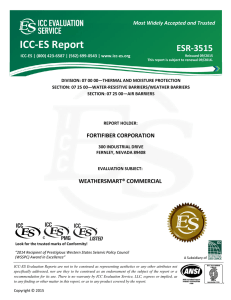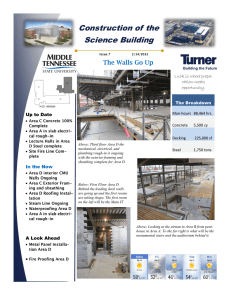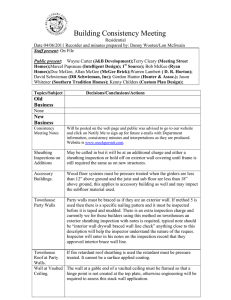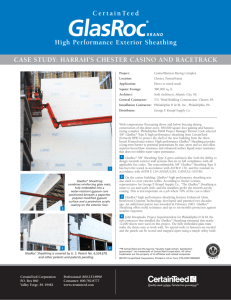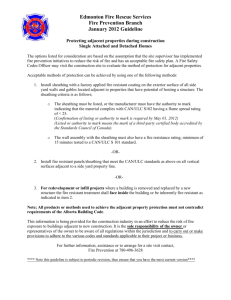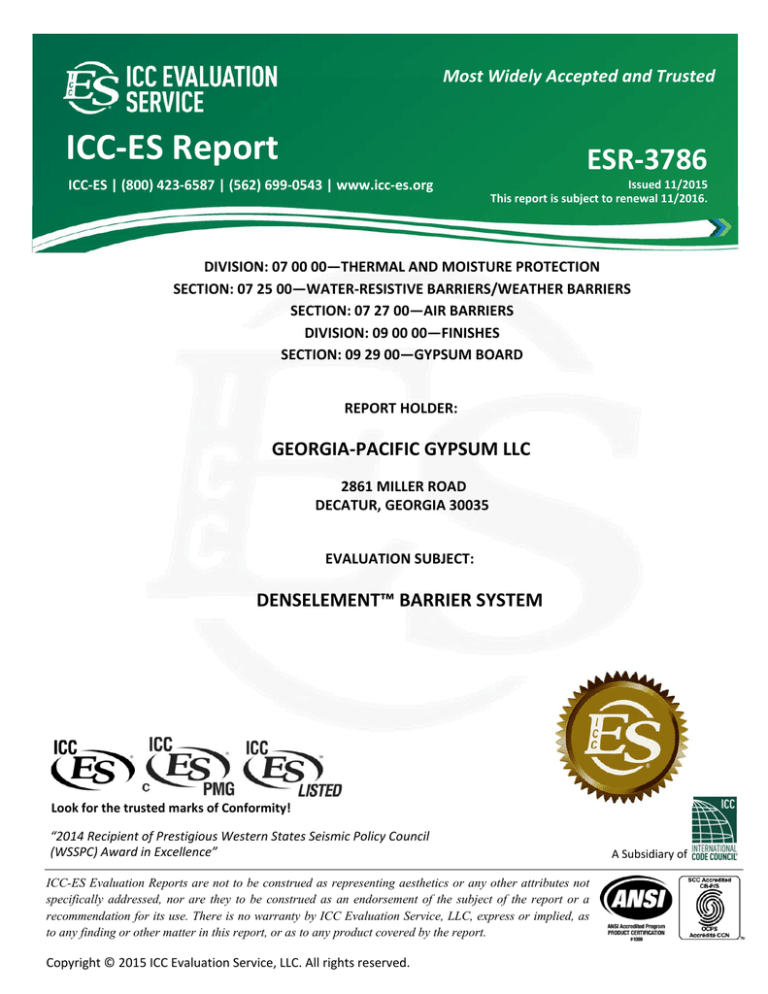
Most Widely Accepted and Trusted 0 ICC‐ES Report ESR‐3786
ICC‐ES | (800) 423‐6587 | (562) 699‐0543 | www.icc‐es.org
000 Issued 11/2015
This report is subject to renewal 11/2016.
DIVISION: 07 00 00—THERMAL AND MOISTURE PROTECTION SECTION: 07 25 00—WATER‐RESISTIVE BARRIERS/WEATHER BARRIERS SECTION: 07 27 00—AIR BARRIERS DIVISION: 09 00 00—FINISHES SECTION: 09 29 00—GYPSUM BOARD REPORT HOLDER: GEORGIA‐PACIFIC GYPSUM LLC 2861 MILLER ROAD DECATUR, GEORGIA 30035 EVALUATION SUBJECT: DENSELEMENT™ BARRIER SYSTEM Look for the trusted marks of Conformity! “2014 Recipient of Prestigious Western States Seismic Policy Council (WSSPC) Award in Excellence” ICC-ES Evaluation Reports are not to be construed as representing aesthetics or any other attributes not
specifically addressed, nor are they to be construed as an endorsement of the subject of the report or a
recommendation for its use. There is no warranty by ICC Evaluation Service, LLC, express or implied, as
to any finding or other matter in this report, or as to any product covered by the report.
Copyright © 2015 ICC Evaluation Service, LLC. All rights reserved.
A Subsidiary of ICC-ES Evaluation Report
ESR-3786
Issued November 2015
This report is subject to renewal November 2016.
www.icc-es.org | (800) 423-6587 | (562) 699-0543
DIVISION: 07 00 00—THERMAL AND MOISTURE
PROTECTION
Section: 07 25 00—Water-resistive Barriers/Weather
Barriers
Section 07 27 00—Air Barriers
described in this report on walls of all types of construction
and dwellings under the IRC. The DensElement™ Barrier
System is intended for use as an alternate to the waterresistive barrier prescribed in Chapter 14 of the IBC and
Chapter 7 of the IRC, as an air barrier material prescribed
in accordance with 2015 IECC Sections C402.5 and
R402.4; 2012 IECC Sections R402.4 and C402.4; 2009
IECC Sections 402.4 and 502.4; IRC Section N1102.4 and
IgCC Section 605.1.2, and as a component of an air barrier
assembly in accordance with 2015 IECC Section C402.5
and 2012 IECC Section C402.4.1.2.2. The sheathing may
be used to resist transverse wind loads when installed in
accordance with Section 4.2.1, and racking loads due to
wind and seismic forces when installed in accordance with
Section 4.2.2. The sheathing may be used as a component
of a fire-resistance-rated wall assembly when installed in
accordance with Section 4.3. The system is classified as a
noncombustible material in accordance with 2015 and
2012 IBC Section 703.5 (2009 IBC Section 1703.4).
DIVISION: 09 00 00—FINISHES
Section: 09 29 00—Gypsum Board
REPORT HOLDER:
GEORGIA-PACIFIC GYPSUM LLC
2861 MILLER ROAD
DECATUR, GEORGIA 30035
(800) 225-6119
www.buildgp.com
EVALUATION SUBJECT:
DENSELEMENT™ BARRIER SYSTEM
3.0 DESCRIPTION
3.1 DensElement™ Sheathing:
1.0 EVALUATION SCOPE
Compliance with the following codes:
®
2015, 2012 and 2009 International Building Code (IBC)
2015, 2012 and 2009 International Residential Code
(IRC)
®
2015, 2012 and 2009 International Energy Conservation
Code® (IECC)
2015 and 2012 International Green
Code™ (IgCC)
A Subsidiary of the International Code Council ®
Construction
Properties evaluated:
Water resistance
Air leakage
Structural
DensElement™ Sheathing complies as a water-resistant
core gypsum substrate in accordance with ASTM C1177
as specified in Table 2506.2 of the IBC and Section
R702.3.1 of the IRC. The glass mat facer of the sheathing
is treated to provide water resistance. The sheathing is
classified as a noncombustible building material in
accordance with ASTM E136. The sheathing is 5/8-inch
(15.9 mm) thick and 48 inches wide (1219 mm), has
square edges and is available in lengths up to 12 feet
(3.7 m).
When tested in accordance with ASTM E96 (water
method), the sheathing has a vapor permeance of
24 perms when tested with a sealed joint and 32 perms
when tested without a joint.
Surface-burning characteristics
When tested in accordance with ASTM E2178, the
2
sheathing has an air permeability less than 0.004 cfm/ft
2
(0.02 L/s•m ) under a pressure differential of 0.3 inches of
water gauge (75 Pa).
Fire-resistance-rated construction
3.2 Liquid Applied Flashing:
Physical properties
The liquid-applied flashing used to seal the sheathing
joints, fastener heads and to flash penetrations must be
Prosoco R-Guard® FastFlash® liquid flashing. The liquidapplied flashing is a polymer based material. The liquidapplied flashing is applied in a 4-inch-wide (102 mm) band
from 16 to 30 wet mils over joints, interfaces and
transitions. Fastener heads must be completely covered
with the liquid flashing material so no portion of the
Noncombustibility
2.0 USES
DensElement™
wall sheathing,
system. This
DensElement™
DensElement™
Barrier System is a combination exterior
air barrier and water-resistive barrier
report recognizes the use of the
Barrier System when installed with the
sheathing and liquid-applied flashing as
ICC-ES Evaluation Reports are not to be construed as representing aesthetics or any other attributes not specifically addressed, nor are they to be construed
as an endorsement of the subject of the report or a recommendation for its use. There is no warranty by ICC Evaluation Service, LLC, express or implied, as
to any finding or other matter in this report, or as to any product covered by the report.
1000
Copyright © 2015 ICC Evaluation Service, LLC. All rights reserved.
Page 1 of 4
ESR-3786 | Most Widely Accepted and Trusted
fastener head is exposed. The flashing material is
packaged in varying quantities tubes and pails. Material
has an approximate shelf life of 12-months from date of
manufacture when stored in a cool dry place.
4.0 DESIGN AND INSTALLATION
4.1 Installation: DensElement™ sheathing must be
attached to wall framing in accordance with ASTM C1280
(Standard Specification for Application of Gypsum
Sheathing) and GA-253 (Application of Gypsum
Sheathing) for IBC applications, or IRC Table R602.3(1)
and IRC Section R702.3.5 for IRC applications; the
manufacturer's published installation instructions; and this
report.
DensElement™ sheathing must be attached with the
yellow-colored side facing the exterior. Sheathing fasteners
must be flushed with the panel surface without
countersinking through the glass mat facer. The sheathing
must not be used as a nailing base and any attachments of
exterior coverings must be made directly to the framing.
Sheathing exposed fastener heads must be sealed with
the liquid applied flashing described in Section 3.2 of this
report to ensure the fastener heads are not exposed. The
sheathing joints, openings, penetrations and transitions
must be sealed with the liquid applied flashing described in
Section 3.2 and as detailed in Sections 4.1.1 of this report.
The sheathing surface must be free of ice and frost during
application of liquid flashing.
4.1.1 The DensElement™ sheathing surface must be free
of contaminants prior to the application of the liquid-applied
flashing. Prior to sealing, treat all exposed gypsum edges
with an approved primer. Apply liquid flashing over the
sheathing joint in a zig-zag or ribbon pattern dispensed
from either a tube-type container or pail and then spread
evenly with a straight edge knife or trowel. Cover a
minimum of 2 inches (51 mm) on both sides of the joints to
achieve a 4-inch (102 mm) width of coverage. Apply at a
rate to achieve a wet mil thickness of 30 mils over the
entire area.
4.1.2 For the perimeter or openings, penetrations,
terminations and transitions, a minimum 6-inch-wide
(152 mm) liquid-applied flashing must be installed in
accordance with Georgia Pacific published installation
instructions. See Figure A for a typical joint, fastener,
opening, penetration and transition sealing details.
The manufacturer’s published installation instructions
and this report must be strictly adhered to, and a copy of
the instructions must be available at all times on the jobsite
during installation.
4.2 Design:
4.2.1 Transverse Wind Resistance: DensElement™
Sheathing may be used to resist transverse wind loads as
permitted by the applicable code for gypsum sheathing.
4.2.2 Shear Resistance: DensElement™ Sheathing
may be used as components of conventional light framed
walls for resisting shear loads when installed as
described in this section.
4.2.2.1 Prescriptive Wall Bracing: The DensElement™
sheathing boards are equivalent to gypsum sheathing for
use as bracing to resist lateral loads due to wind and
seismic forces. When installed as prescribed by code for
gypsum sheathing, the DensElement™ sheathing board
may be used as wall bracing in accordance with 2015 IBC
Section 2308.6.3, Method GB; 2012 and 2009 IBC Section
2308.9.3, Method 5; subject to the limitations in IBC
Page 2 of 4
Section 2308.2, or in accordance with 2015 and 2012 IRC
Section R602.10.4, Method GB; 2009 IRC Section IRC
R602.10.2, Method GB, as applicable.
4.2.2.2 Engineered Shear Walls: The DensElement™
sheathing boards may be used as a component of
engineered shearwalls when designed in accordance with
IBC Section 2305 for wood framed walls or 2015 and 2012
IBC Section 2211.6; 2009 IBC Section 2210.6 for light
steel framed walls. The design wind and seismic loads
must not exceed the allowable racking shear capacity for
gypsum sheathing shown in the AWC 2015 SDPWS for
recognition under the 2015 IBC and 2015 IBC Table
2306.3(3); AF&PA 2008 SDPWS for recognition under
the 2012 IBC and 2012 IBC Table 2306.3(3); and the
2009 IBC Table 2603.7. Design wind loads must be
determined in accordance with Section 1609 of the IBC.
Design seismic loads must be determined in accordance
with Section 1613 of the IBC.
For seismic design, the substrate may be used as a
component of wood-framed engineered shear walls for
resisting seismic loads in Seismic Design Categories A, B,
C, and D. The response modification factor, R, must be
equal to 2; the system overstrength factor, Ωo, must be
1
equal to 2 /2; and the deflection amplification factor,
Cd, must be equal to 2. The maximum building height is
35 feet (10.6 m) for buildings located in Seismic Design
Category D areas.
Structural members, systems and components, including
boundary studs and plates, must be anchored to resist
design forces and to provide continuous load paths for
these forces to the foundation.
4.3 Fire-resistance-rated Wall Assemblies:
4.3.1 One-hour Fire-resistance-rated Load-bearing
5
Wall: The /8-inch-thick (15.9 mm) DensElement™
Sheathing is installed vertically to both faces of a wood
stud partition wall with nominal 2-by-4 studs at 16 inches
(406 mm) on center. The wall must be bridged every 5 feet
(1524 mm), maximum, and the board on one face installed
with joints staggered 16 inches (406 mm) from those on
the opposite face. The boards are attached using 1¾ inchlong (45 mm) galvanized nails with a 7/16-inch-diameter
(11.1 mm) head and 0.128-inch-diameter (3.25 mm)
shank, spaced 8 inches (203 mm) on center at edges and
intermediate studs. Allowable bearing loads must not
exceed 2030 pounds (9030 N) per stud, 78 percent of the
allowable F’c, or 78 percent of the calculated stress with
studs having a slenderness ratio, le/d, of 33, whichever is
less.
4.3.2 Other Fire-resistance-rated Construction: One
layer of DensElement™ Sheathing may be substituted for
the gypsum sheathing specified for exterior faces of
assemblies Nos. 13-1.1, 13-1.3, 14-1.3, 14-1.5, 15-1.1, 151.5, 15-1.6 of 2015 and 2012 IBC Table 721.1(2) (2009
IBC Table 720.1(2)).
4.4 Air Barrier Assembly: DensElement™ Sheathing
fastened to 16-inch-center (406 mm), steel-framed wall,
using No. 6 self-drilling screws spaced at 8 inches
(203 mm) on center in the field and perimeter, leaving a
1
/8-inch (3.2 mm) gap between panels, forms an air barrier
assembly when the gaps between the panels and the
perimeter of penetrations are sealed with the liquid
flashing, as described in Section 4.1. The assembly has
2
demonstrated an air leakage less than 0.04 cfm/ft
2
(0.2 L/s•m ) under a pressure differential of 0.3 inches of
water gauge (75 Pa) when tested in accordance with
ASTM E2357.
ESR-3786 | Most Widely Accepted and Trusted
4.5 Water-resistive
Barrier
Assembly:
The
DensElement™ Barrier System when installed in
accordance with Section 4.1 of this report may be used as
an alternate to the water-resistive barrier prescribed in IBC
Chapter 14 or IRC Chapter 7.
5.0 CONDITIONS OF USE
The DensElement™ Barrier System described in this
report complies with, or is a suitable alternative to what is
specified in, those codes listed in Section 1.0 of this report,
subject to the following conditions:
5.1 The products must be manufactured, identified and
installed in accordance with this report, the
manufacturer's published installation instructions and
the applicable code. If there is a conflict between the
manufacturer's published installation instructions and
this report, this report governs.
5.2 When the sheathing is not installed as bracing, as
described in Section 4.2.2.1, or as an engineered
shear wall, as described in Section 4.2.2.2, the stud
walls must be braced by other materials in
accordance with the applicable code.
5.3 Shear walls using the sheathing must not be used to
resist forces imposed by masonry and/or concrete
walls.
5.4 The DensElement™ Barrier System must be covered
with a code complying exterior wall covering.
6.0 EVIDENCE SUBMITTED
6.1 Reports of physical property testing in accordance
with ASTM C473, for compliance with ASTM C1177.
Page 3 of 4
6.3 Reports of noncombustibility tests in accordance with
ASTM E136.
6.4 Reports of tests on a fire-resistance-rated wall
assembly in accordance with ASTM E119 (UL 263)
and fire analysis.
6.5 Data in accordance with Sections 4.1, 4.2, 4.3, 4.4 4.7
and 4.8 of the ICC-ES Acceptance Criteria for Waterresistive Coatings Used as Water-resistive Barriers
Over Exterior Sheathing (AC212), dated February
2015.
6.6 Data in accordance with Section 4.5 of the ICC-ES
Acceptance Criteria for Water-resistive Membranes
Factory Bonded to Wood-based Structural Sheathing,
Used as Water-resistive Barriers (AC310), dated May
2008 (editorially revised June 2013).
6.7 Report of flashing tests with applicable AAMA 714
standard for liquid-applied flashing described in
Section 3.2 of this report.
6.8 Report of air leakage tests in accordance with ASTM
E2178 and ASTM E2357.
6.9 Quality documentation.
7.0 IDENTIFICATION
Each DensElement™ Sheathing board is identified with the
manufacturer’s name (Georgia-Pacific Gypsum LLC), a
plant identifier and date code, the product name, the board
thickness, and the evaluation report number (ESR-3786).
The liquid flashing must be identified with the product
name and company name described in Section 3.2 of this
report.
6.2 Reports of surface-burning tests in accordance with
ASTM E84 (UL 723).
DensElement™ Barrier System; Figure A
Details for joint, fastener, opening, penetration, and transition sealing using liquid-applied flashing:
Fasteners to Framing Sealing with Fluid-Applied Flashing
ESR-3786 | Most Widely Accepted and Trusted
Page 4 of 4
Joint Sealing: Fluid-Applied Flashing
Opening Sealing, Window Sill and Jamb: Fluid-Applied Flashing
Penetration Sealing: Fluid-Applied Flashing
Opening Sealing, Window Jamb and Header:
Fluid-Applied Flashing
Material Transition Sealing: Fluid-Applied Flashing
ICC-ES Evaluation Report
ESR-3786 CBC and CRC Supplement
Issued November 2015
This report is subject to renewal November 2016.
www.icc-es.org | (800) 423-6587 | (562) 699-0543
A Subsidiary of the International Code Council ®
DIVISION: 07 00 00—THERMAL AND MOISTURE PROTECTION
Section: 07 25 00—Water-resistive Barriers/Weather Barriers
Section: 07 27 00—Air Barriers
DIVISION: 09 00 00—FINISHES
Section: 09 29 00—Gypsum Board
REPORT HOLDER:
GEORGIA-PACIFIC GYPSUM LLC
2861 MILLER ROAD
DECATUR, GEORGIA 30035
(800) 225-6119
www.buildgp.com
EVALUATION SUBJECT:
DENSELEMENT™ BARRIER SYSTEM
1.0 REPORT PURPOSE AND SCOPE
Purpose:
The purpose of this evaluation report supplement is to indicate that the DensElement™ Barrier System, recognized in ICCES master report ESR-3786, has also been evaluated for compliance with 2013 CBC Chapters 7, 14, 22, 23 and 25 and
2013 CRC Chapters 6 and 7.
Applicable code editions:
2013 California Building Code (CBC)
2013 California Residential Code (CRC)
2.0 CONCLUSIONS
2.1 CBC:
The DensElement™ Barrier System, described in Sections 2.0 through 7.0 of the master evaluation report ESR-3786,
complies with CBC Sections 703.2, 703.5, 1404.2, 2211.6, 2306.3, 2308.9.3, 2506 and 2508, provided the design and
installation are in accordance with the 2012 International Building Code® (IBC) provisions noted in the master report and the
additional requirements of CBC Chapters 7, 14, 22, 23 and 25, as applicable.
The system recognized in this supplement has not been evaluated under CBC Chapter 7A for use in the exterior design
and construction of new buildings located in any Fire Hazard Severity Zone within State Responsibility Areas or any
Wildland–Urban Interface Fire Area.
2.2 CRC:
The DensElement™ Barrier System, described in Sections 2.0 through 7.0 of the master evaluation report ESR-3786,
complies with CRC Sections R703.2 and R602.10.4, provided the design and installation are in accordance with the 2012
®
International Residential Code (IRC) provisions noted in the master report.
The system recognized in this supplement has not been evaluated under CRC Section R327 for use in the exterior design
and construction of new buildings located within any Fire Hazard Severity Zone within State Responsibility Areas or any
Wildland–Urban Interface Fire Area.
The products recognized in this supplement have not been evaluated for compliance with the International Wildland–Urban
®
Interface Code .
This supplement expires concurrently with the master report issued November 2015.
ICC-ES Evaluation Reports are not to be construed as representing aesthetics or any other attributes not specifically addressed, nor are they to be construed
as an endorsement of the subject of the report or a recommendation for its use. There is no warranty by ICC Evaluation Service, LLC, express or implied, as
to any finding or other matter in this report, or as to any product covered by the report.
1000
Copyright © 2015 ICC Evaluation Service, LLC. All rights reserved.
Page 1 of 1
ICC-ES Evaluation Report
ESR-3786 FBC Supplement
Issued November 2015
This report is subject to renewal November 2016.
www.icc-es.org | (800) 423-6587 | (562) 699-0543
A Subsidiary of the International Code Council ®
DIVISION: 07 00 00— THERMAL AND MOISTURE PROTECTION
Section: 07 25 00—Water-resistive Barriers/Weather Barriers
Section: 07 27 00—Air Barriers
DIVISION: 09 00 00—FINISHES
Section: 09 29 00—Gypsum Board
REPORT HOLDER:
GEORGIA-PACIFIC GYPSUM LLC
2861 MILLER ROAD
DECATUR, GEORGIA 30035
(800) 225-6119
www.buildgp.com
EVALUATION SUBJECT:
DENSELEMENT™ BARRIER SYSTEM
1.0 REPORT PURPOSE AND SCOPE
Purpose:
The purpose of this evaluation report supplement is to indicate that the DensElement™ Barrier System, recognized in
ICC-ES master report ESR-3786, has also been evaluated for compliance with the codes noted below.
Applicable code editions:
2014 Florida Building Code—Building
2014 Florida Building Code—Residential
2.0 CONCLUSIONS
The DensElement™ Barrier System, described in Sections 2.0 through 7.0 of the master evaluation report ESR-3786,
complies with the 2014 Florida Building Code—Building and the 2014 Florida Building Code—Residential, provided the
design and installation are in accordance with the International Building Code® (IBC) provisions noted in the master report.
Use of the DensElement™ Barrier System for compliance with the High-Velocity Hurricane Zone provisions of the 2014
Florida Building Code—Building and the 2014 Florida Building Code—Residential has not been evaluated, and is outside the
scope of this evaluation report.
For products falling under Florida Rule 9N-3, verification that the report holder’s quality-assurance program is audited by a
quality-assurance entity approved by the Florida Building Commission for the type of inspections being conducted is the
responsibility of an approved validation entity (or the code official when the report holder does not possess an approval by
the Commission).
This supplement expires concurrently with the master report issued November 2015.
ICC-ES Evaluation Reports are not to be construed as representing aesthetics or any other attributes not specifically addressed, nor are they to be construed
as an endorsement of the subject of the report or a recommendation for its use. There is no warranty by ICC Evaluation Service, LLC, express or implied, as
to any finding or other matter in this report, or as to any product covered by the report.
1000
Copyright © 2015 ICC Evaluation Service, LLC. All rights reserved.
Page 1 of 1

